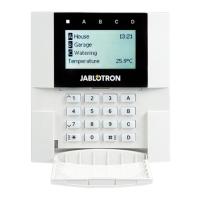
Do you have a question about the jablotron JA-10 Series and is the answer not in the manual?
| Brand | jablotron |
|---|---|
| Model | JA-10 Series |
| Category | Security System |
| Language | English |
Outlines the fundamental requirements for system setup and compliance with norms.
Details default access codes and system profiles, including 4- and 6-digit code options.
Explains how administrators or technicians can create or modify user access codes and RFID tags.
Discusses user authorization levels, combinations, and increasing security with double authorization.
Provides a schedule for recommended maintenance and functional checks of system components.
Describes how the system can be divided into sections and common sections for coverage.
Explains basic system control via keypads, including functional buttons and status indicators.
Details the control panel's design for small/medium systems and its communication capabilities.
Describes the function and color meaning of COMM, FAULT, GSM, and USB LEDs.
Details connectors for supplementary modules, radio modules, and tamper contacts.
Explains mains power connection, BUS terminal, and USB connector usage.
Describes the 4-wire BUS system for JA-10 devices and its power/data terminals.
Specifies resistance values for BUS cables and installation guidelines.
Explains BUS length limits, device capacity, and voltage loss considerations.
Provides an example calculation of total BUS device consumption for backup.
Details backup battery requirements for Security Grade 2 compliance.
Guides on installing the radio module for wireless communication and optimal placement.
Explains the process of enrolling wireless devices using N-Link software.
Allows pre-setting system parameters to comply with norms and security grades.
Describes system modes like Service, Unset, Set, Alarm, and Fault.
Explains user roles, authorization levels, and default administrator/technician codes.
Covers various system settings and optional parameters configurable via N-Link.
Details the procedures for adding and removing devices from the system via N-Link.
Defines system reactions to device activations, categorized by event type.
Discusses functions like confirmed reaction and three-strikes to prevent false alarms.
Explains different alarm types (Intrusion, Fire, Panic) and siren outputs (IW/EW).
Describes how intrusion alarms are triggered and indicated.
Explains tamper detection for devices and the control panel itself.
Details fire alarm triggers, types (basic, confirmed, instant), and gas detection.
Describes Silent and Audible panic alarms and their triggering methods.
Covers alarms for continuous protection, regardless of system status.
Explains how authorized users can cancel active alarms.
Lists common system faults, their causes, and indications.
Details how the system detects and reports loss of communication with devices.
Explains how authorization is key for controlling the system and verifying users.
Details system control and monitoring via keypads, including setting procedures.
Describes how to control the system remotely using wireless remote controllers.
Explains automated system control and PG output management via the internal calendar.
Covers remote system control using mobile applications like MyJABLOTRON.
Details remote control via voice menu using GSM or PSTN communicators.
Explains how to control the system and query status using SMS commands.
Describes system control and status overview through the N-Link software.
Explains the duress code function for silent panic alarms under threat.
Lists factors that can prevent system setting based on device status or faults.
Details the function that detects and reports failed system setting attempts.
Summarizes event reporting groups for SMS and voice calls to users.
Provides an overview of acoustic feedback for keypads and sirens.
Covers functions for disabling or blocking devices and sections.
Explains device disabling and input blocking options for service technicians.
Describes controlling system functions and PG outputs via authorized users.
Guides on connecting N-Link, initializing the control panel, and setting system size.
Used to configure parameters for independently monitored sections (zones).
Allows enrolling devices, setting parameters, and viewing device status.
Used to establish system users and define their access rights and permissions.
Used to set functions and links for programmable outputs (PG outputs).
Defines the links for PG output activation based on devices, calendar, or events.
Defines how the system reports events to users via SMS or voice calls.
Used to set control panel parameters and selectable functions.
Allows checking device status, battery, RF signal quality, and BUS voltage/loss.
Used to set time schedules for automatic system events like arming/disarming.
Sets the behavior of communicators and communication methods (GSM, LAN, PSTN).
Configures the JA-190Y supplementary GSM communicator settings.
Configures network parameters for the LAN communicator.
Configures the JA-190X PSTN telephone communicator settings.
Used to set communication parameters for Alarm Receiving Centres (ARCs).
Details ATS class parameters required for ARC communication paths.
Explains protocols (SIA, JABLO IP, JABLO SMS) for GSM/LAN communication.
Lists CID and SIA event codes and their corresponding report categories.
Explains automatic settings for photo transmission via MyJABLOTRON service.
Describes controlling system sections locally or remotely via N-Link software.
Explains how to access and manage event history stored on the microSD card.
Details how to set system behavior, devices, users, and communicators via N-Link.
Provides graphical representation of radio interference and signal quality.
Explains switching between Unset and Service modes for system changes.
Describes updating internal device settings after hardware changes.
Covers connecting or disconnecting N-Link from the control panel via USB.
Explains remote connection via the Internet, requiring proper setup and registration.
Allows saving contact and system installation details for future reference.
Guides on updating firmware for control panel and connected devices.
Outlines rules and procedures for updating firmware via N-Link.
Details FW update process for BUS devices and control panel via N-Link.
Explains FW updates for wireless devices, including radio and USB cable methods.
Describes post-update checks for settings and device functionality.
Provides a summary of technical data for the system and its devices.
Lists current consumption for BUS devices in backup and cable selection modes.
Details current consumption of control panels with and without communication modules.
Provides physical dimensions of the control panel unit.
